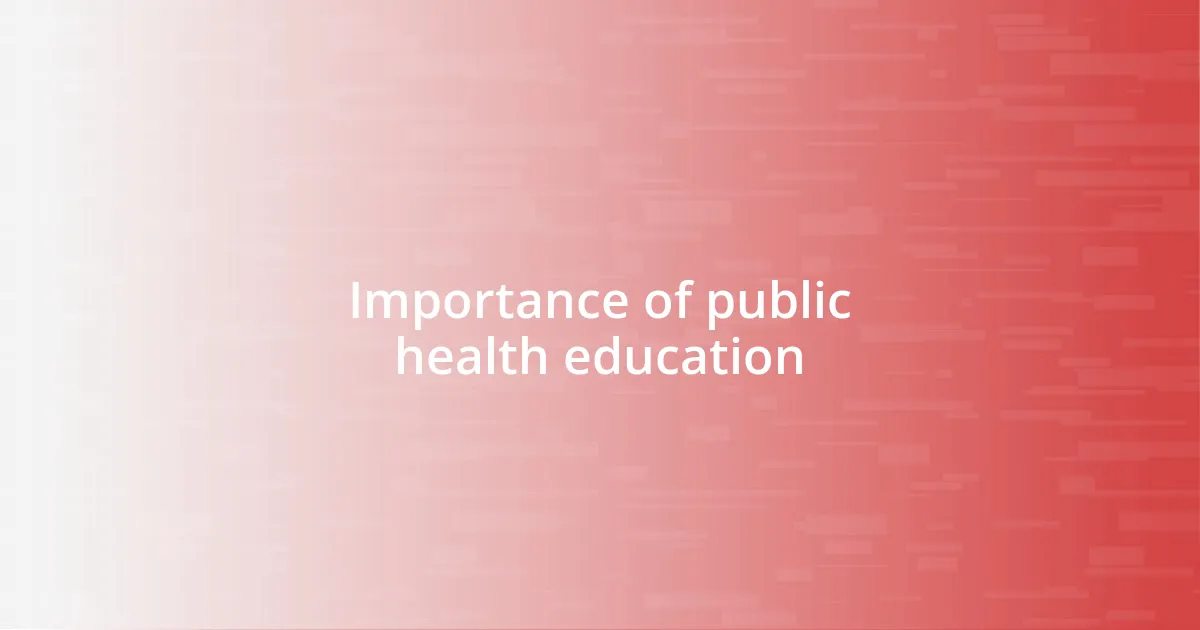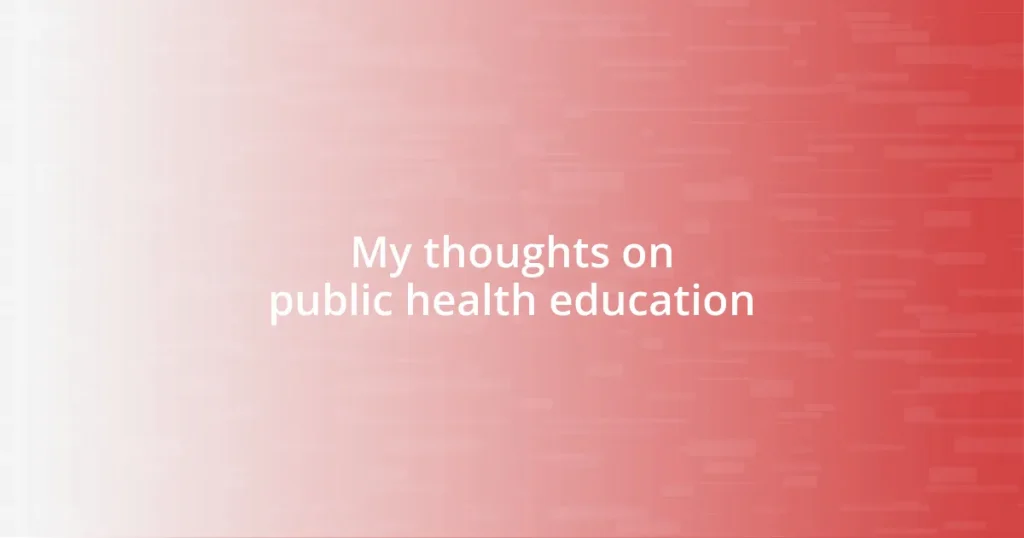Key takeaways:
- Public health education empowers individuals to make informed health decisions and reduces disease spread through community engagement.
- Key components of effective education include audience engagement, relatable examples, and ongoing support to encourage lasting behavior changes.
- Innovative strategies like community partnerships and social media outreach enhance participation and foster a supportive environment for health education.
- Evaluating educational program effectiveness should focus on behavior change and adapt based on ongoing feedback to better meet community needs.

Importance of public health education
Public health education plays a pivotal role in equipping individuals with the knowledge they need to make informed health decisions. I remember a time when I attended a community health workshop, which opened my eyes to the impact simple lifestyle changes can have on overall well-being. Have you ever thought about how much we often overlook our health until it’s too late?
When people are well-informed about preventative measures, they can actively reduce the spread of diseases. For instance, after learning about the significance of vaccines, I felt empowered to educate my friends and family on why they should prioritize immunizations. This ripple effect highlights how public health education not only benefits individuals but also creates a healthier community, where everyone looks out for one another.
Furthermore, public health education fosters resilience in times of crisis. During the recent pandemic, I witnessed firsthand how understanding the facts about transmission and prevention saved lives. Wouldn’t it be amazing if more individuals had access to this vital information? By prioritizing public health education, we can cultivate a society that is better prepared to face health challenges head-on.

Key components of effective education
Effective education in public health hinges on several key components that ensure the message resonates. One of the most critical aspects is audience engagement. I recall a local health seminar where the speaker invited attendees to share their health concerns, which made the session feel personal. This interactive approach not only held our attention but fostered a sense of community as we all shared our journeys.
Another essential component is the use of relatable, culturally relevant examples. In one session on nutrition, the facilitator brought in favorite local dishes and suggested healthier versions. This sparked conversations and made it much easier for people to visualize making sustainable changes. It’s remarkable how familiar context can drive home important lessons and inspire real-life application.
Lastly, ongoing support and resources are crucial. After attending a workshop on stress management, I received a follow-up email with useful online tools and local support groups. This continued engagement reinforced the initial education and encouraged lasting behavioral change. Wouldn’t it be great if all health education provided such valuable resources to maintain momentum?
| Component | Description |
|---|---|
| Audience Engagement | Involves participants actively in discussions to build community and personal connection. |
| Relatable Examples | Utilizes familiar, culturally relevant scenarios to enhance understanding and application. |
| Ongoing Support | Provides resources and follow-up to reinforce learning and encourage behavior change. |

Strategies for engaging communities
Engaging communities in public health education requires innovative strategies that resonate on a personal level. I remember when my local health department organized a health fair, highlighting services through fun activities like free health screenings and cooking demonstrations. The energy was infectious, and people felt more inclined to participate, making health education feel less like a lecture and more like a community celebration.
Here are some effective strategies to enhance community engagement in public health education:
- Collaborate with Local Organizations: Partnering with schools, churches, and community centers helps reach diverse populations.
- Utilize Social Media Platforms: Many community members are active online; sharing engaging content can spark conversations and spread awareness.
- Incorporate Interactive Workshops: Hands-on activities, like cooking classes or fitness challenges, make learning about health fun and practical.
- Share Personal Stories: Real-life testimonials can create emotional connections and illustrate the positive impact of health education.
- Resource Accessibility: Ensure information is available in various formats and languages to accommodate all community members.
By embracing these strategies, communities can create a network that champions health education in a way that feels inclusive and inviting.

Utilizing social media for outreach
Social media has truly revolutionized how we can reach out to communities about public health. I’ll never forget the time my local health organization launched a campaign on Instagram to promote mental health awareness. They shared short videos from community leaders discussing their personal experiences with anxiety and depression. Not only did this make the issue feel relatable, but it also encouraged others to share their stories and seek support. Isn’t it fascinating how a simple post can spark such powerful dialogue?
Engaging visuals and interactive content on platforms like Facebook or Twitter can dynamically enhance communication. I’ve seen infographics that break down complex health data into digestible snippets, making it easier for people to understand crucial information. When a post went viral, comments poured in, with users asking questions and sharing tips. This created a real sense of a supportive online community—who doesn’t appreciate that kind of shared knowledge?
Moreover, social media enables us to reach a wider audience incredibly quickly. An example that stands out is a health challenge that went viral on TikTok, where participants shared videos of themselves following healthy tips. Watching others take part was both inspiring and motivating. It made me wonder—what if every public health message had this kind of engaging, interactive quality? The potential for meaningful public health outreach is exciting, and leveraging social media is a key part of achieving that goal.

Evaluating educational program effectiveness
Evaluating the effectiveness of educational programs in public health is crucial for understanding their impact. I recall a community initiative that aimed to improve dietary habits among adolescents. After implementing the program, we surveyed participants and noticed a marked increase in their knowledge about nutrition, but here’s the kicker: the real success came when we saw a genuine change in their food choices. It made me reflect—how often do we measure only knowledge gained, rather than behavior change?
I’ve learned that a mixed-methods approach offers one of the best ways to evaluate such programs. By combining quantitative data, like surveys and attendance rates, with qualitative feedback from participants, we can gather a richer understanding of effectiveness. For instance, in a wellness workshop I attended, participants shared their personal journeys, which provided invaluable insights into what worked and what didn’t. Isn’t that powerful? Hearing firsthand accounts can often shed light on nuanced aspects that mere statistics might miss.
Lastly, continuous assessment really makes a difference. Programs that adapt based on ongoing feedback tend to be more successful. After a pilot program on sexual health education, we conducted follow-up interviews, and it was enlightening to see how responsive adjustments helped address community concerns. It made me ponder—what if we treated every public health initiative as a dynamic conversation, rather than a fixed deliverable? Embracing this mentality could transform how we design and implement these essential programs.

Addressing barriers to participation
Addressing barriers to participation in public health initiatives requires a nuanced understanding of the community’s needs. One time, I volunteered at a health fair and noticed several people hesitated to join the wellness activities. When I asked them why, many cited language barriers or fears of judgment. It struck me—if we don’t consider these factors, we risk leaving vulnerable populations behind.
Another key barrier I’ve encountered is access to reliable information. During a family gathering, I overheard a relative express confusion about vaccine information due to misinformation online. I felt a wave of frustration; it reminded me how crucial it is to provide clear, trusted resources for everyone. Establishing partnerships with local organizations can facilitate better dissemination of accurate health information, ultimately fostering community trust.
Additionally, the timing and location of programs can significantly impact participation. I once organized a workshop on diabetes management held during a weekday afternoon. Attendance was low, and I learned that many in our community were working. Reflecting on this, I now prioritize offering events at various times and in more accessible locations to ensure everyone has a chance to engage. Doesn’t it make sense to create opportunities that work for the people we aim to serve?















